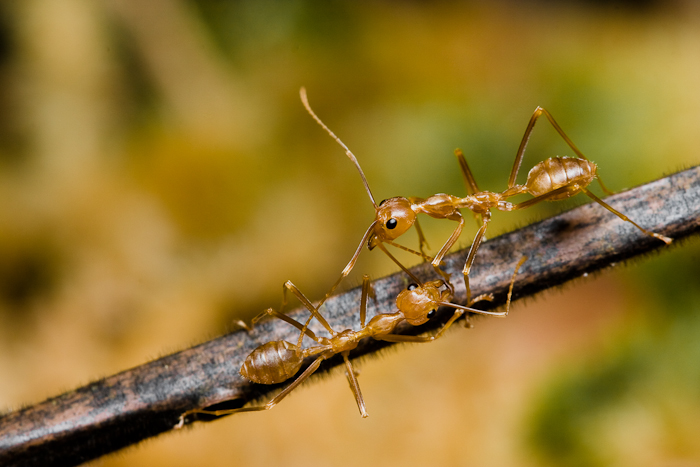© Milan Janda
An introduction to weaver ants
Weaver ants are best known for their remarkable nest construction. Using precise coordination, the weaver ants create very strong ant chains by linking legs to pull and bend leaves into desired tent like positions. The ants then use their own larvae to secrete a silk that is used to stitch leaves together to create a nest. They may have several nests dominating a few trees at once.
They are very aggressive territorial ants and for over 1000 years they have often been used by farmers to control agricultural pests.
Weaver ant workers have a vice like grip and tremendous strength. Weaver ants have been recorded to support 100 times their own weight, whilst standing upside down on glass! see ant facts no 2.
Scientific names
Oecophylla smaragdina (featured), Oecophylla sp.
Distribution
Weaver ants can be found in Australia and South East Asia, particularly Philippines.
Habitat
Weaver ant nests are usually found in forest trees, but can also be seen in any high up crevices, including roofs and telegraph poles.
Diet
Weaver ants farm scale bugs for their honeydew, they also eat small insects.
Colony size
Established weaver ant colonies can reach up to half a million individuals.
Queen
Weaver ant queens are typically around 20-25mm, they are normally greenish brown. They are a monogyn species (one queen per colony).
Workers
5-6mm. Mostly orange. Sometimes this species has bright green gasters. Minor workers tend to look after the brood and farm scale bugs for honey dew.
Major workers
Major workers are slightly larger at 8-10mm. They are mostly orange. This ant has long strong legs, long flexible antennae and large mandibles. They forage, maintain and expand the nest.
Risk
Strong mandibles allow for a painful slicing bite, they spray formic acid into any wounds. Weaver ants tend to be very aggressive and responsive to disturbance.
Pet level 3
Risk declarations must be completed if this species is housed outside of its country of origin.
Weaver ants are high maintenance and tricky to keep in captivity. They require controlled temperatures, humidity, live leafy trees, lots of live bugs for food and a suitable sized tank to hold the tree. The equipment setup is expensive. It’s best to see them in the wild or museums and zoos.



















